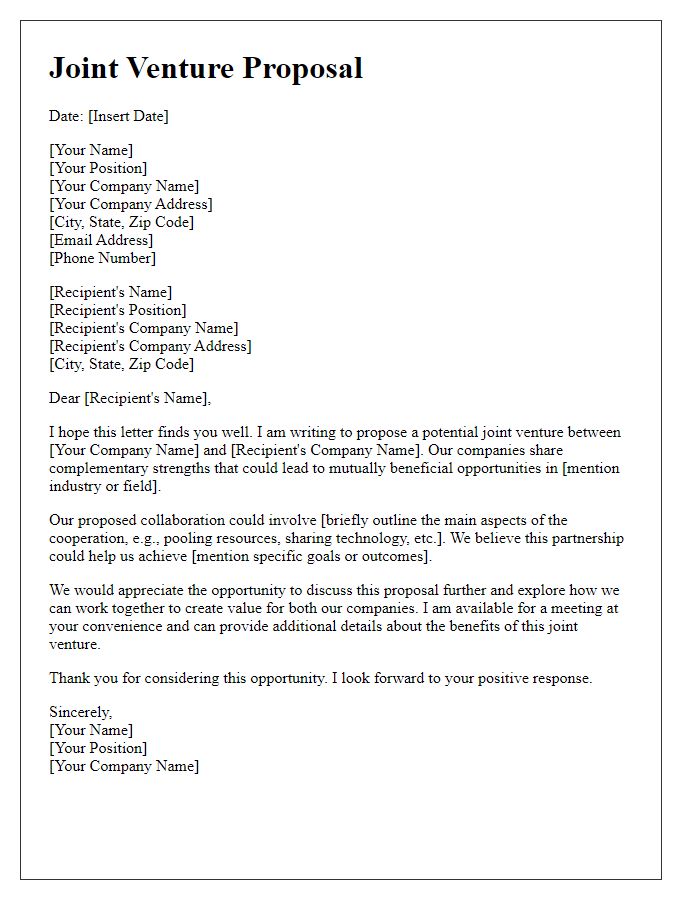Are you considering a partnership that could elevate your business to new heights? Crafting a compelling letter to express your interest can set the right tone for a fruitful collaboration. In this article, we'll explore effective strategies to convey your enthusiasm and outline mutual benefits. Dive in to discover how to make your letter stand out and pave the way for successful partnerships!

Clear Introduction
A clear introduction to a potential business partnership should begin by establishing the identity of the entity involved, such as a company name, its industry, and location. For instance, "ABC Innovations, a technology firm based in Silicon Valley, has been at the forefront of AI research since its inception in 2010." This includes a brief mention of the company's mission and vision, highlighting its commitment to advancement and collaboration in the tech landscape. For example, emphasizing "ABC Innovations aims to enhance user experience through cutting-edge solutions that prioritize sustainability." Establishing this context not only defines the entity but also sets the stage for the value proposition in the proposed partnership.
Alignment of Goals
A partnership focused on aligning goals can lead to significant mutual benefits for organizations. Strategic collaborations, such as those between non-profits and businesses, have the potential to amplify social impact and enhance brand reputation. For instance, partnerships formed during global events like the United Nations Climate Change Conference (COP26) can catalyze efforts toward sustainability initiatives. These alliances enable resource sharing and joint ventures, building greater community engagement and awareness. Additionally, aligning missions with reputable organizations can foster innovation and create competitive advantages, resulting in shared success and enhanced visibility in the marketplace. Organizations pursuing such partnerships should clearly outline compatible objectives and establish frameworks for transparent communication to maximize collective impact.
Unique Value Proposition
A unique value proposition defines a business's distinct advantages compared to competitors. In today's competitive landscape, partnerships can amplify these advantages and enhance service offerings. For example, combining innovative technology solutions from a startup specializing in artificial intelligence with an established firm's vast customer reach can create a compelling market presence. The partnership aims to deliver enhanced efficiency in data processing, resulting in customer satisfaction and retention. Collaborative marketing strategies and shared resources can also lead to cost savings and increased brand visibility, ultimately driving revenue growth for both entities. Effective communication and clearly defined goals will ensure a mutually beneficial relationship, positioning both companies as leaders in their respective fields.
Call to Action
A partnership opportunity with established organizations can lead to collaborative projects that leverage shared resources, expertise, and networks. Engaging in joint ventures could enhance market reach, improve innovation capabilities, and increase overall impact within the industry. By combining strengths, partners can achieve mutual benefits, such as expanded customer bases or enhanced product offerings. Inviting potential partners to discuss ideas can spark creative solutions and pave the way for successful ventures. Interested organizations should reach out to explore synergistic possibilities and outline potential contributions that align with shared goals.
Contact Information
The successful promotion of sustainable farming practices requires strategic collaboration among organizations. Partnerships can leverage shared resources, expertise, and innovation within agricultural sectors. These cooperative efforts often lead to the development of environmentally friendly technologies, which enhance productivity while reducing carbon footprints. Local farms, research institutions, and governmental agencies can benefit from joint ventures, aligning their goals with community needs and global sustainability targets. Noteworthy initiatives include programs supported by the United Nations' Food and Agriculture Organization, focusing on food security and climate change adaptation strategies in developing countries. Such alliances foster knowledge exchange, improve market access, and ultimately drive economic growth for participating entities.













Comments